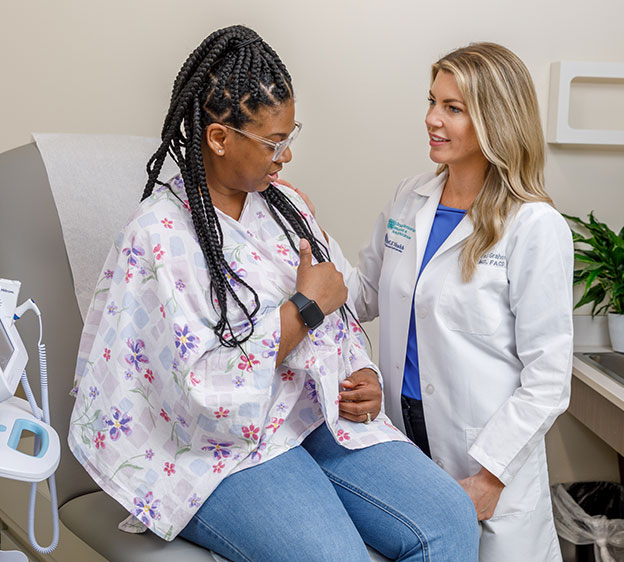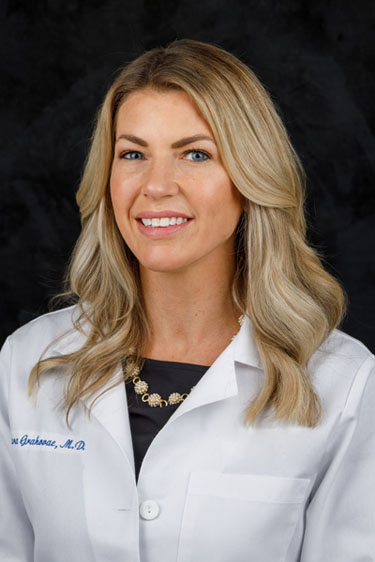
If you regularly perform breast self-exams, you likely know to feel for lumps. It’s also important to inspect your skin closely. Breast dimpling and other skin changes are signs that something is amiss and that it’s time for your women’s health provider to weigh in.
Breast Dimpling: What Is It and What Does It Mean?
Breast dimpling is a term that describes skin with a slightly rough texture similar to the skin of an orange. It’s sometimes called orange peel skin.
Breast dimpling is a concerning symptom because it may be a sign of inflammatory breast cancer, an aggressive and rare form of breast cancer. Inflammatory breast cancer accounts for 1% to 5% of breast cancer cases and often isn’t diagnosed until late stages, when it has begun to spread. Younger women, African American women and women who are obese have an increased risk for inflammatory breast cancer.
However, skin dimpling is not always a sign of breast cancer. It can occur after a breast tissue biopsy, breast surgery, injury or a bruise. These procedures can lead to a condition called fat necrosis, which occurs when breast tissue dies or becomes damaged. Fat necrosis can cause lumps in the breast, and the lumps may sometimes be surrounded by dimpled skin. Usually benign, fat necrosis can heal on its own, but some women need surgery to remove it.
When to See a Doctor About Breast Dimpling
Because breast dimpling can be a sign of inflammatory breast cancer, it’s always a good idea to get it checked out by your women’s health provider.
Breast dimpling may be serious if it is accompanied by additional symptoms of breast cancer, including:
- Discharge that is not breast milk
- Lump in the armpit or breast
- A nipple that is drawing inward
- Pain in the breast or nipple
- Red, scaly skin
- Swelling or thickening of the breast
Read More: Know Your Lemons: How to Do a Breast Self-Exam
The Benefits of Screening
While all women should know their breasts and what looks and feels normal for them, regular screening mammograms allow your provider to identify cancer early, before outward signs develop.
“We encourage women to perform monthly self-exams so they are alert to subtle changes in the size, shape and skin of their breasts,” says Dr. Tara Grahovac, FACS, board-certified, fellowship-trained breast surgeon with the Beaufort Memorial Breast Care & Surgery Program. “However, a mammogram is a much better tool for detecting breast cancer and increasing the likelihood of successful treatment.”
For women at average risk, breast cancer screening should begin at age 40 and continue annually as long as they are in good health. Women with the following breast cancer risk factors should start screenings earlier:
- A history of radiation to the chest
- Having a close family member diagnosed with breast cancer at a young age, usually under 50
- A history of certain benign breast conditions
- Mutations in the BRCA1, BRCA2 and other genes
Taking hormone replacement therapy can also increase your risk for breast cancer. Talk with your provider if you take these medications and how it may influence your risk.
Beaufort Memorial uses 3D mammograms to screen for breast cancer. This technology uses X-rays to take three-dimensional images that offer greater detail than traditional 2D mammograms. Women with dense breasts or whose providers need additional information from their screenings may need automated breast ultrasound or MRI along with a mammogram. Your provider can tell you which imaging tests you need.
Read More: Breast Density and Cancer Risk
Taking Charge of Your Breast Cancer Risk
You can’t choose your family, your past medical history or your genetics, but you can control your lifestyle. Adopting healthy habits not only lowers your risk of breast cancer, but it also lowers your risk for many other cancers and chronic diseases.
You can lower your risk by:
- Breastfeeding your children if you can
- Exercising most days of the week
- Limiting alcohol intake to no more than one drink per day
- Maintaining a healthy weight
Read More: Take Control of Your Breast Cancer Risk Factors
“Being proactive about your risk is one of the best moves you can make,” Dr. Grahovac says. “In addition to lifestyle changes, be sure you have a good relationship with an OBGYN or other women’s health provider who can help you understand concerning symptoms, like skin dimpling, and recommend the right next step. We understand that visual signs of breast cancer can be very concerning, but we can also help determine what they mean and if they do, in fact, mean you have breast cancer.”
Has it been a while since your last mammogram or other cancer screening? Find a Beaufort Memorial women’s health specialist who can help you stay on track.

